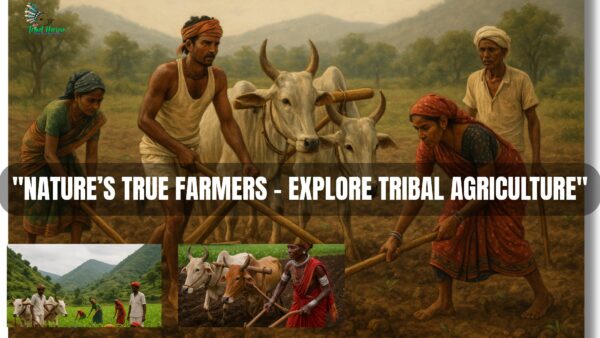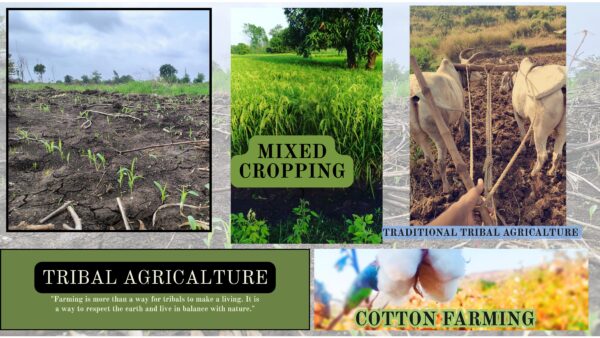
What is tribal Agriculture?
Tribal agriculture is a way of growing food that families and communities have practised for generations. This traditional method helps people understand their land deeply and protect the diversity of plants and animals. Tribal farming is not just about producing food — it also reflects culture, community living, and the spiritual bond people share with nature.
Why is Tribal Agriculture Important in Today’s Context?
Tribal agriculture offers valuable lessons in growing food naturally, without harmful chemicals. While modern farming dominates today, these traditional methods highlight eco-friendly ways to cultivate crops that protect nature and local biodiversity.
These traditional methods:
How does tribal agriculture work with nature?
In India, tribal agriculture thrives on harmony with nature. Tribal farmers often rely on natural fertilisers such as cow dung, leaf litter from the forest, and ash from burnt leaves. They consciously avoid synthetic fertilisers and harmful pesticides, embracing traditional farming methods that honour the soil and support sustainable agriculture.
Tribal farmers promote eco-friendly farming practices that keep the soil fertile and alive. Avoiding chemicals encourages the natural growth of beneficial insects like earthworms, which thrive in healthy soil. This traditional approach results in strong crop yields and pure, chemical-free grains.
India relies on age-old practices like intercropping and crop rotation to ensure healthy harvests. Growing different crops together supports mutual growth and reduces losses. Seasonal rotation helps replenish soil nutrients naturally, while also preventing pest infestations, without the use of harmful chemicals
The Traditional Base of Tribal Agriculture in India
The livelihoods of tribal communities in India are intricately tied to agriculture, which embodies centuries-old traditions that uphold a deep connection with nature. Unlike the modern practices of chemical farming, our tribal folks rely on time-honoured knowledge handed down through generations. Tillage is carried out using traditional ploughs, often drawn by bullocks. An elder in the community shared that ploughing with bullocks keeps the soil loose and fertile, ensuring a productive harvest.
Historical Method and Connection with Nature in Tribal Agriculture
Tribal agriculture is an ancient practice that connects people to nature. It relies on the diversity of natural resources to be sustainable. Many traditional tribal methods include agroforestry and crop rotation, which promote organic farming. These methods are passed down through generations and highlight the importance of understanding and conserving the environment for future generations.
Age-old customs and natural coexistence:
Tribal communities understand the climate and their environment. They observe natural signs to predict weather changes and plan their farming. This helps their crops thrive and reduces damage. They pass this knowledge to future generations, helping to keep nature balanced.
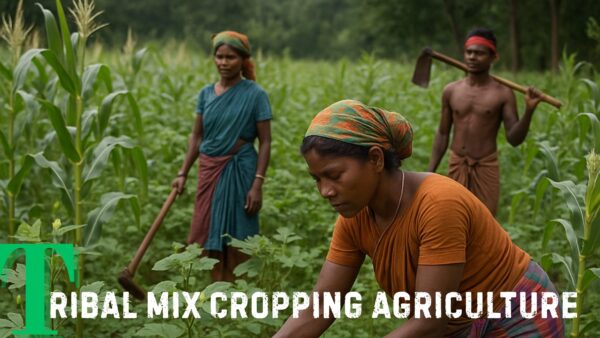
Tribal agriculture has long included agroforestry as a key practice, as tribal communities traditionally live in and around forests. Where there is a forest, there are tribal people — and their farming reflects a deep respect for nature. They grow crops without harming the trees, preserving the forest and maintaining ecological balance.
Mixed farming is a traditional agricultural practice, particularly common among tribal communities. It involves cultivating two or more crops simultaneously in the same field. For instance, if tur (pigeon pea) is planted, native rice can be sown in the gaps between the tur plants. This approach offers multiple benefits, such as producing two crops at once and conserving fertiliser, time, and water.
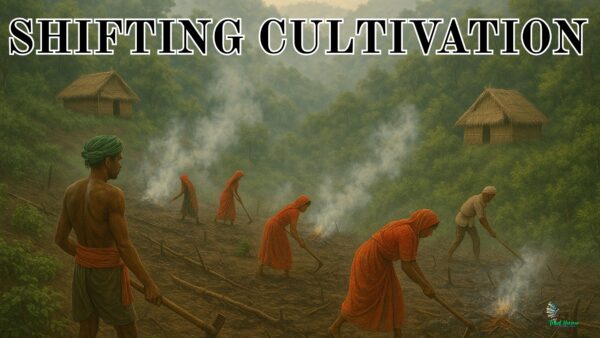
Shifting cultivation is a traditional farming method tribal communities use, especially in northeastern India. In this method, farmers clear a small area of forest. When the grass grows, they dry it and burn it to prepare the land for planting crops. After about three years, when crop yields start to decline, they leave that area and move to a new one to repeat the process. This allows the old land to recover naturally. Many tribal communities in eastern and southern India also use this method, which has different names in various regions.
This method has different names in various regions, including: – Jhum Kheti (northeastern India) – Podu Kheti (Orissa and Andhra Pradesh) – Dipa Kheti (Madhya Pradesh and Chhattisgarh) – Valtre (Rajasthan) – Kurava (Jharkhand) – Bevar/Dahiya (Madhya Pradesh) – Kumari (Western Ghats) – Padma Dabi (Odisha)
In tribal agriculture, communities grow only the crops they need to survive — not for profit, but to feed themselves. They believe in living in balance with nature, so they move from place to place without harming the land or its natural resources. They take only what nature offers, nothing more.
Tribal farmers often use chemical or synthetic pesticides for pest control. They do this instead of using neem and other insecticidal plants found in the forest.
Tribal Agriculture as Ancestral Ritual
The tribal communities of India have practised agriculture for generations. For them, farming is more than just a way to earn a living; it is a cultural and spiritual activity deeply rooted in their traditions. They regard the land as their mother and show it reverence. Before farming, they sought her forgiveness, following the teachings of their ancestors.
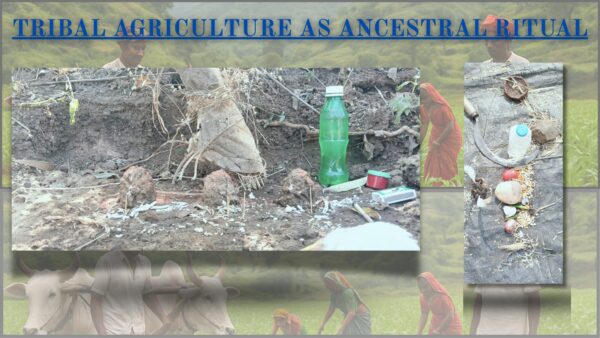
Key features:
1. Considering sowing seeds as a natural, auspicious act:
Tribal communities are closely connected to nature, especially during the rainy season. They rely heavily on rain for their livelihoods. To ensure their seeds remain viable, they store them in ashes for a whole year. When the time comes to sow, they demonstrate deep respect by bowing down and reciting ancestral prayers. Furthermore, after the rains, they engage in rituals and worship before planting their seeds, honouring their beliefs and traditions.
2. Faith in the land and nature
Tribal communities have thrived for generations, regarding water, forests, and land as sacred, like a mother. Through tribal agriculture, they understand that the land nourishes them, and they show gratitude for its gifts while seeking forgiveness for any harm caused. This deep-rooted respect for nature guides their choice to avoid chemical fertilisers and pesticides. Instead, they follow organic and sustainable farming practices, cultivating food in harmony with the earth. Their commitment to protecting natural resources reflects a spiritual and ancestral connection to the land.
3. Deep bond between farming and festivals
The tribal community enjoys the entire farming process — from sowing seeds to weeding and harvesting — as a collective activity filled with joy and connection. This is not just labour; it is a tribal ritual in itself, where farming becomes a way of honoring both nature and tradition. They celebrate their agricultural work with happiness and a festive spirit, often singing folk songs in their native tongue as a way to thank the earth and the elements.
After harvesting, the new grain is never consumed immediately. According to tribal belief, it must first be offered to their kul devi (family goddess). This sacred offering is an important ritualistic act, followed by a grand harvest festival where the entire community gathers to express gratitude, perform traditional dances, and share food — reinforcing their deep spiritual bond with the land.
4. Natural methods and organic farming:
They do not use fertilizers or medicines. Instead, they dig a deep pit and bury dung for six months to a year until it rots. This rotted dung is then used as fertilizer. To keep pests away, they spray neem leaves on the plants and roots.
Why Tribal Agriculture Still Matters Today
Tribal agriculture is still important today, and understanding its principles is essential. These farming methods are often passed down through generations, but they remain effective and sustainable, especially during natural disasters.
Eco-friendly farming practices
Tribal farming avoids chemical fertilisers and pesticides, relying on natural methods and more manure to promote healthy, pest-free plants. This eliminates the need for pesticides and results in crops rich in natural nutrients, which is especially important today.
Faith and sensitivity for land and nature
Tribal people do not view the land solely as a resource for agricultural production; they see it as a paternal figure. For them, the land is essential for their survival, providing food and sustenance. Farming is treated like a religious ritual, and they take great care to preserve the land, only taking what they need and avoiding any damage.
Tribal Contribution to Ecological Balance
Tribal farming practices such as forest protection, soil erosion control, water conservation, and biodiversity conservation are beneficial. Their adoption of agroforestry and mixed cropping naturally protects the soil and crops from damage, maintaining the natural balance.
Chemical-Free and Healthy Harvests
Tribal farming methods utilize natural products that are both chemical-free and pest-free. As a result, the grains, vegetables, and fruits produced through these methods are typically free from pesticides. This approach helps maintain a healthy body by ensuring access to complete nutrients. Therefore, food derived from tribal farming is of higher quality and better for human health.
Tribal Agriculture in Crisis: The Fight for Land and Livelihood
The obstacles that tribal farmers encounter are significant and varied. Let us have a closer look at the key factors influencing their struggles.
Land alienation
Displaced tribal communities are being forcibly removed from their ancestral lands under the pretext of land transfer. Frequently, in the name of development, their land is taken or sold without their consent. This issue is also depicted in some films based on true events.
Why Tribal People Are Losing Their Land?
Tourist destinations are being developed, and dams are being constructed for vital water storage, while large portions of government land are being acquired for mining and road projects. In the midst of this rapid development,
tribal agriculture is under serious threat. Outsiders are increasingly grabbing land in tribal areas, disrupting traditional ways of life. Many tribal families lose their ancestral lands after taking small loans during festivals, unknowingly signing away their rights. As the land vanishes, so does the foundation of tribal farming, which depends on a deep connection to the soil, forests, and natural rhythms.
This issue stems largely from the absence of legal land documents. Moreover, forest laws and regulations unjustly restrict traditional land rights, leaving communities vulnerable to arbitrary changes. We must address these challenges to protect the rights and livelihoods of those affected.
FQA
What is tribal agriculture?
Tribal farming involves traditional practices by tribal communities that utilise natural resources and seasonal cycles, maintaining environmental balance without chemical inputs.
Where is tribal agriculture practiced in India?
Tribal farming is common in Odisha, Chhattisgarh, Jharkhand, Madhya Pradesh, Gujarat, and parts of the Northeast, where many communities live near forests and hills. 90% of these communities rely on traditional farming methods.
How can tribal agriculture be protected?
Legal land rights protect tribal agriculture, but their implementation is minimal and requires improvements, validation of traditional knowledge, and government support.
How is tribal agriculture different from modern farming?
Tribal farming is different from modern farming because it doesn’t use chemical fertilisers or pesticides. Instead, it uses cow dung, manure, ash, and grows different crops together. It focuses on keeping a natural balance without relying on modern methods.
Can tribal agriculture survive in an era of climate change?
Tribal farming is often more natural and resilient than modern methods. Techniques like mixed cropping, using local seeds, and forest-based practices help adapt to climate change while protecting the environment.
Conclusion
Tribal agriculture is far more than just a farming system; it embodies a profound way of life that is intimately connected to nature, deeply respectful of the seasons, and grounded in cooperation within the tribal community. This sustainable approach to farming eschews chemical fertilizers and pesticides, drawing instead on natural resources such as manure, ash, and native seeds for cultivation. It is a powerful example of sustainable tribal farming in action.
Today, however, tribal farming faces formidable challenges, including land displacement, coal mining, and various pressures from modern society. It is imperative that we protect their land, amplify their voices, and acknowledge their rights. The water, forests, and land rightfully belong to these tribal communities, and they are the best stewards of these precious resources.
Preserving tribal farming is not just a matter of health; it is a crucial step in securing a sustainable and thriving planet for future generations. Our collective responsibility is to support these efforts and ensure that traditional practices endure.
In free to share your feedback. If you have any issues or any kind of questions, you can comment below. Thank u….

